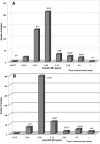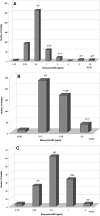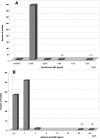Susceptibility of Neisseria meningitidis to 16 antimicrobial agents and characterization of resistance mechanisms affecting some agents
- PMID: 16000430
- PMCID: PMC1169190
- DOI: 10.1128/JCM.43.7.3162-3171.2005
Susceptibility of Neisseria meningitidis to 16 antimicrobial agents and characterization of resistance mechanisms affecting some agents
Abstract
Neisseria meningitidis represents a pathogen of great public health importance in both developed and developing countries. Resistance to some antimicrobial agents used either for therapy of invasive infections or for prophylaxis of case contacts has long been recognized, although specific guidelines for susceptibility testing have not been fully developed. We have examined the susceptibilities of a collection of 442 meningococcal clinical isolates from 15 countries to 16 antimicrobial agents. These included isolates recovered between 1917 and 2004, with representatives of all major serogroups. All isolates were tested by the Clinical and Laboratory Standards Institute (formerly NCCLS) broth microdilution method using Mueller-Hinton lysed horse blood broth, while a subset of 102 isolates was tested by agar dilution using Mueller-Hinton sheep blood agar. Most isolates provided adequate growth for MIC determinations by both broth and agar methods. Growth in broth was enhanced by CO(2) incubation and was required for two strains (1.7%). MICs of the study drugs compared favorably between the broth and agar methods (79 to 100% essential agreement), and MICs also generally agreed closely (92 to 100% essential agreement, excluding azithromycin) between broth tests incubated in the two different atmospheres. Elevated penicillin and ampicillin MICs (> or =0.12 microg/ml and > or =0.25 microg/ml, respectively) occurred in 14.3% and 8.6% of strains and were associated with polymorphisms of the penA gene encoding a modified penicillin-binding protein 2. None of the 442 isolates produced beta-lactamase. Elevated tetracycline and doxycycline (but not minocycline) MICs were associated with efflux-mediated resistance encoded by tet(B) in 13 strains. Resistance to sulfisoxazole in 21.7% of strains and to trimethoprim-sulfamethoxazole in 21.0% resulted from polymorphisms of folP encoding a modified dihydropteroate synthetase. Seven strains were resistant to rifampin due to mutations in the rpoB gene, and two strains were resistant to chloramphenicol due to production of chloramphenicol acetyltransferase mediated by catP. Two strains had reduced quinolone susceptibility due to mutations of gyrA. The determination of the susceptibilities of a large group of meningococcal strains (including strains with characterized resistance mechanisms) to 16 antimicrobial agents has served as the essential first step in defining susceptibility testing breakpoints specific for this organism.
Figures








Comment in
-
Surveillance of antimicrobial resistance in Neisseria meningitidis from patients in the Cincinnati tristate region (Ohio, Kentucky, and Indiana).J Clin Microbiol. 2006 Apr;44(4):1592-3. doi: 10.1128/JCM.44.4.1592-1593.2006. J Clin Microbiol. 2006. PMID: 16597904 Free PMC article. No abstract available.
References
-
- Antignac, A., P. Kriz, G. Tzanakaki, J.-M. Alonso, and M.-K. Taha. 2001. Polymorphism of Neisseria meningitidis penA gene associated with reduced susceptibility to penicillin. J. Antimicrob. Chemother. 47:285-296. - PubMed
Publication types
MeSH terms
Substances
Grants and funding
LinkOut - more resources
Full Text Sources
Medical

